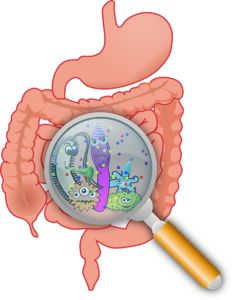What’s living in your gut?
 The digestive system or “gut” is home to trillions of microscopic bacteria that live in our gastrointestinal (GI) tract and play a major role in our health. Our gut is a really complex environment that consists of both beneficial (good) and harmful (bad) bacteria that are known as our “gut flora”. Gut flora is predominantly found in our intestines, which are in the lower part of our stomach area. The intestines are long, tube-like organs that help you digest food, absorb vitamins, and eliminate waste.
The digestive system or “gut” is home to trillions of microscopic bacteria that live in our gastrointestinal (GI) tract and play a major role in our health. Our gut is a really complex environment that consists of both beneficial (good) and harmful (bad) bacteria that are known as our “gut flora”. Gut flora is predominantly found in our intestines, which are in the lower part of our stomach area. The intestines are long, tube-like organs that help you digest food, absorb vitamins, and eliminate waste.
So, what exactly makes our good gut flora so important?
- It helps with the production of Vitamin B and Vitamin K.
- It helps to establish healthy digestion.
- It aids in digesting certain carbohydrates that our stomach and intestine cannot digest.
- It discourages harmful bacteria and yeasts from overgrowing and making us sick.
- It aids in the absorption of nutrients from our food.
- It plays a role in the development of immune cells that help fight off viruses when we are sick.
Over your lifetime, your gut bacteria continually changes. Some changes are due to the normal aging process, while other changes are caused by diet and lifestyle. For example, studies have shown that artificial sweeteners can alter your gut flora by reducing the amount of good bacteria in your gut. Though we know that our gut flora composition is dependent on age, eating certain foods can also increase your good bacteria count. Probiotics and prebiotics are two things that are found in the foods that we eat, and can help us increase our good bacteria counts.
Probiotics: Live bacteria that can be found in some foods that we eat, and are good for your health and digestion.
Probiotic foods that you can add to your diet:
- Yogurt
- Sour Kraut (German fermented cabbage)
- Dark Chocolate
- Kefir (a dairy drink that is similar to yogurt)
- Pickles
- Miso Soup
- Tempeh (a grain made from soy beans that is used as a meat or soy substitute)
- Kimchi (Asian fermented cabbage)
- Kombucha Tea (fermented tea)
Prebiotics: A special form of fiber (a carbohydrate in plant foods) that good bacteria in your gut can “feed” on. This, in turn, fuels the growth of more healthy bacteria in the gut.
Prebiotic foods that you can add to your diet:
- Raw Jerusalem artichoke
- Raw garlic
- Raw leeks
- Raw onion
- Cooked onion
- Raw asparagus
- Bananas
Because both good and bad bacteria are constantly fighting for control in the gut, eating probiotics and prebiotics are both great ways that we can help the good bacteria outnumber the bad. In addition to these foods, probiotics also come in pill form and can help establish healthy gut bacteria and alleviate digestion problems. These pills can be purchased at health food stores, drug stores, and some grocery stores. Remember, because probiotics contain live bacteria, they have a shorter shelf life than other pills/vitamins and should be refrigerated.
– Jen

